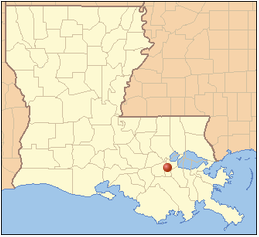| Home | Search | Emissions | Pollutants | About the Database |

Marathon Ashland Petroleum (3165), Garyville
LDEQ Accident Report
| Accident # | 137005 |
| State Police # | 12-00701 |
| Accident Date | 2012-02-04 |
| Report Date | 2012-02-26 |
| Follow-up Date | 0000-00-00 |
| Follow-up: | No |
Pollutants Released
| Pollutant | Duration | Point Source | Greenhouse Gas | Criteria Pollutant | Ozone forming chemical | Amount of Release |
| Sulfur Dioxide | 31min | Unit 259 North Ground Flare (EQT #0282) | NO | YES | NO | 8,904.0 pounds |
Accident Classified As: Reportable Quantity
Cause of Problem: Power Failure
During the Unit 215 Startup on February 4, 2012, the Recycle Gas Scrubber foamed shortly after the lean amine circulation started causing a high level in the Recycle Gas KO Drum, shutting down the Recycle Compressor. Shortly after the Recycle Compressor was re-started, a high temperature wave went through the Train 2 Guard reactor and activated the Train 2 Guard Bed No. 3 bottom catalyst layer rate of change trip initiating a high rate de-pressure via ESD-1. There were no known off-site impacts. On February 4, 2012, 2274 pounds of SO2 were released. On February 5, 2012, 6630 pounds of SO2 were released.
Discharge Preventable - No
This release was not preventable. The removal of the anti-foam from the Unit 232 amine system by the carbon filter was unforseeable. The electrical surge, initiating event, caused by a cable fault on the Unit 215 charge pump motor causing the low voltage on the sub feeding multiple pieces of equipment in Unit 210 and through Domain 9 was unforseeable.
Notes/Remedial Actions
Calculations for SO2 emissions provided in attachments 1A and 1B. LABB was unable to find attachments. The compressor was re-started initially. The Emergency Shutdown (ESD) system activated as designed. An incident investigation was conducted to determine the cause or causes of the incident. Per this investigation, the root causes were identified as 1. procedures wrong- situation not covered and 2. equipment difficulty- design specs need improvement. The recommendations (actions) from the investigation were 1. determine correct Unit 232 operation while Unit 215 is shutdown to ensure that sufficient anti-foam is in the system- completed on 3/19/12; 2. add a step to the unit 215 startup procedure to ensure that Unit 232 is injecting high rates of antifoam at least one hour prior to taking amine- completed 10/1/12; and 3. adjust the ESD logic to increase the temperature at which the rate of change alarms become active - completed 9/19/12. Two incident investigations were conducted to determine the cause or causes of the incident. The first investigation focused on the cause of the electrical failure in Unit 215 which was the origin of the problems in Unit 210. Per this first investigations, the root cause was identified as Equipment difficulty- problem not anticipated. This first investigation had four recommendations (actions) which were 1) have IR windows reinstalled on the 215-1501-A charge pump motor connection box during the next available shutdown- due 8/15/14; 2) Logically "AND" a "50N2T" element to the "RUNNING" element and add it to the trip logic for all 15KV motors that are protected by SEL-710 relays -due 2/29/16; 3) Convert all 15KV connection boxes in service and warehouse stock to include rupture panels - due 8/15/14; and 4) modify standard practice SP-60-27 and SP-60-29 for all induction and synchronous motors to include the requirement for a rupture panel to be installed on the motor connection box- 8/2/12. The second investigation focused on the shutdown of the U210 off-gas compressor, source of the flaring in this incident. Per this investigation, the root causes were identified as 1) Training- understanding needs improvement, 2) Human engineering- human machine interface, 3) communication- no communication or not timely. And 4) Procedures- followed incorrectly. This second investigation had six recommendations (actions ) which were 1) review the need for quickly restarting the compressor with domain 9 operations personnel- completed 3/28/12; 2) Add to board operator training outline a section to review critical actions following the loss of multiple pieces of equipment- completed 6/29/12; 3) raise the priority of the alarm for the suction drum vent valve open to flare from high to urgent- completed 3/29/12; 4) lock the primary alarm summary display on the DCS to sort alarms by priority- completed 3/29/12; 5) review the incident and the need for clear and concise communication during upset conditions with Domain 9 operations personnel- completed 3/28/12; and 6) revise the Unit 210 Off-Gas compressor startup procedure to specify that the board operator loads the compressor and verifies good operation- completed 5/1/12.

Connect With Us: